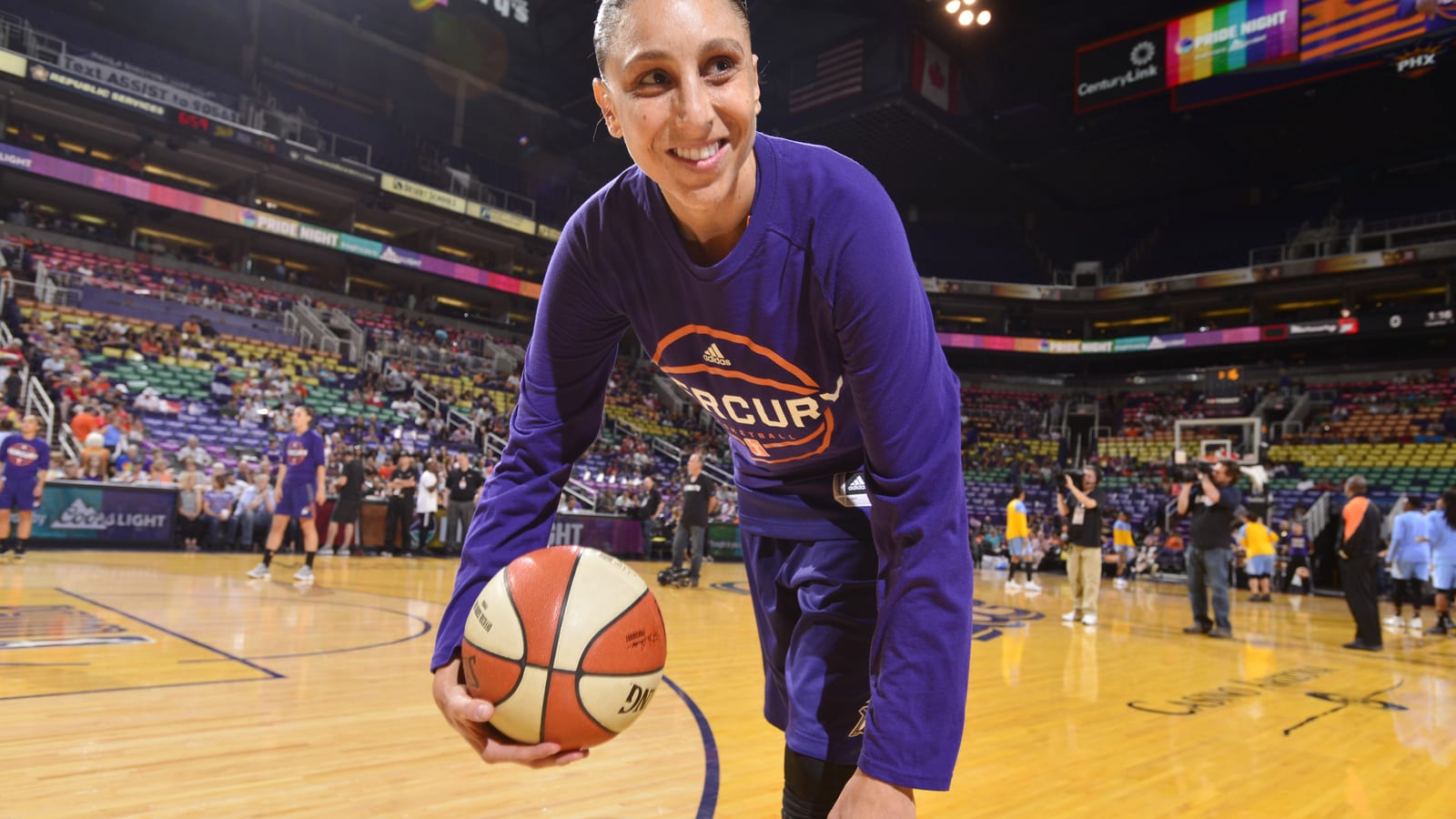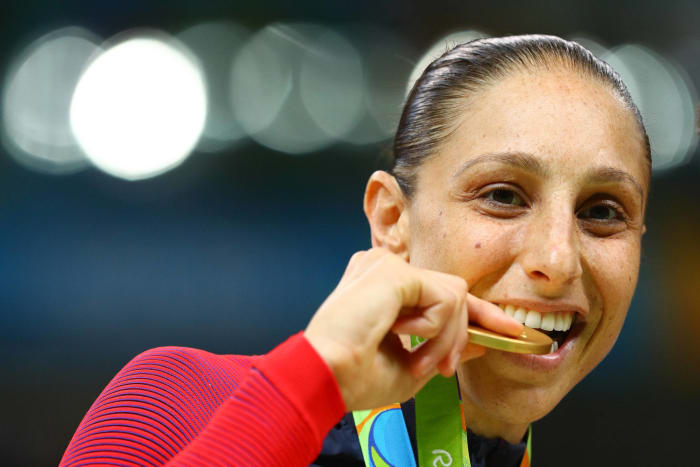
Diana Taurasi setting the WNBA all-time scoring record is another leap for the league
She scored her first points for the Phoenix Mercury on May 20, 2004, by cutting around defenders in the perimeter for an open three-pointer. Adrian Williams-Strong was sitting in the post against Sacramento Monarchs center Yolanda Griffith when she saw the dynamic rookie guard out of UConn in her purview. A quick flick of the wrist was the start of a career that would shatter records, inspire and challenge future generations of athletes, and most importantly, help push a fledgling league to greater heights.
From that moment, you just knew that it wouldn’t take long for Diana Taurasi to remake the Mercury and the WNBA in her own image.
To fully appreciate Taurasi’s career – one that could go on forever, if she chooses – you have to understand how much the WNBA has evolved since its launch in 1997. After all, the future Hall of Famer was part of one of the early waves of players who came of age as high schoolers who would finally see a stable professional women’s league on North American shores. She knew what it was like to carry the reins of an evolution at Connecticut, a program that was already the cream of the crop in the women’s game since the Rebecca Lobo era of the early 1990s. Even some of the best to ever play for Geno Auriemma stand in awe of her accomplishments in Storrs – four Final Fours, three national titles, multiple individual honors.
Yet, how she was doing it was far different: She was and remains a quick-footed guard with unbelievable range, underrated stamina and superior vision. You could list a number of male players her game emulates in comparing to something more familiar, and though it’s not totally fair to female hoopers, it’s also a bit of a testament to how unique DT’s style has always been. For many of us who also came of age along with Taurasi, we immediately noted that she had a "pro game" at UConn, one that was much more assertive and individualistic than what’s usually celebrated among the college ranks. Yet, the best in basketball players can balance their own scoring with the efforts of their teammates, and though more of a shooting guard than a point guard, Taurasi was a very good passer in college.
Players with some, if not all, of Taurasi’s skill set were certainly in the WNBA, but it was a league that was built off of veterans who logged a huge bulk of their prime years internationally. They were still superb athletes, and like the league’s first two-time MVP, Cynthia Cooper (1997, 1998), undeniably brilliant because of their experience, but youth was no longer on their side. Though the WNBA was drafting players straight out of the college ranks from jump – the initial Elite Draft gave the league Tina Thompson, whom Taurasi passed on Sunday – it wasn’t until the 2000s where the real youth infusion was taking shape. The 2001 Draft alone could be considered the league’s best ever – the first round featured Lauren Jackson (#1, Seattle), Tamika Catchings (#3, Indiana), Ruth Riley (#5, Miami), Deanna Nolan (#6, Detroit), Katie Douglas (#10, Orlando) and Penny Taylor (#11, Cleveland). Taurasi’s former UConn teammates dominated in 2002 as four of the first six picks were Huskies, led by #1 overall pick Sue Bird, the alleged "Logowoman" and second all-time career assists leader. 2003 was highlighted by Cheryl Ford – daughter of Hall of Famer Karl Malone – Plenette Pierson and Kara Lawson. (Notably, former track star Marion Jones was drafted in the third round.)

Taurasi entered the league that was moving further away from the post-oriented play thanks to players of her peer age group. Sure, Catchings, Riley and Taylor flourished in the paint, but they had a shooter’s touch in the perimeter, opening up cutting lanes for their smaller teammates. Bird’s vision remains second to none, even in her 16th season with the Seattle Storm. Forwards and tall guards became interchangeable – just as Elena Delle Donne – but DT dominated because few had her shot selection or her speed off the ball. Her aggressiveness wasn’t completely reckless; in fact, she is one of the few pure guards to rank in the top 25 of career true shooting percentages. Taurasi’s field goal percentages have slipped some in the last two seasons; she’s career 43.5% shooter, and it wasn’t until last season where she didn’t make the 40% mark for a season – just .396 in 2016 and .372 so far in 2017. And she’d probably remind you that she’s a trusting teammate and a playmaker thanks to being fifth all-time in career assists. (None of this mentions her dominant play in European pro leagues and Olympic/FIBA competition.)

Her long-range game comes to mind for most observers, knocking down a league-record 933 (and counting) triples in her career. Yet, the mental image her opponents have been unable to shake remains a jab step from the three-point line before she would find daylight and make a deft drive to the rim. Both are incredible complements of each other – if a defender couldn’t keep pace with her, she’d find a screen and buy at least one more second for an open three or blitz to the basket for an acrobatic layup. Being a second or two faster than everyone else is how Taurasi became the first player to eclipse the 800-point mark in a WNBA season, only one of two to have score more than 800 in a season (Maya Moore did it in 2014), and the only one to have done so twice (2006, 2008).
Taurasi could have broken the WNBA scoring record long ago, if not for missing most of 2012 due to injury and her decision to skip the 2015 WNBA season to make much more money with UMMC Ekaterinburg of the Euroleague. And while it’s easy to wonder how much further she could have pushed career records out of reach if not for those two season – perhaps she would have become the first 10,000-point player in WNBA history in 2018 – it’s even easier to marvel at what the 35-year-old is still doing right now. Just as Tina Thompson, Cynthia Cooper, Sheryl Swoopes and many others did in the years before her arrival, Diana Taurasi is setting a new standard for another generation of players to reach for when she finally retires. Taurasi is signed with Phoenix, the only WNBA team she’s ever played for, through 2020, meaning that her high marks will have reshaped the league in ways never previously imagined.
More must-reads:
- Diana Taurasi becomes WNBA’s all-time leading scorer
- Feeding your roundball addiction through the summer months
- The 'First overall WNBA draft picks' quiz
Breaking News
Customize Your Newsletter
 +
+
Get the latest news and rumors, customized to your favorite sports and teams. Emailed daily. Always free!

